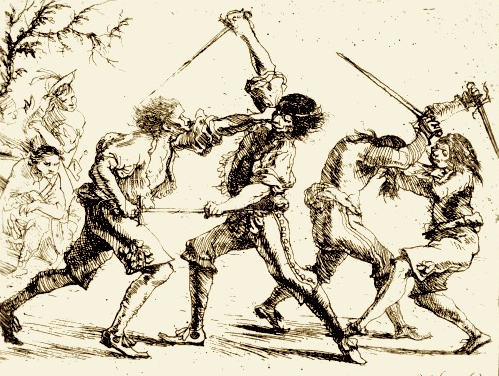Worst Case Scenarios
By
John Clements
ARMA Director
 It's
a long-standing truism in the modern study of martial arts that what works
in the classroom typically fails on the street. Thus, to prepare yourself
seriously you need to train for real world scenarios. In a sense, doing
so is really about making disaster preparedness your default training
conditions. It's
a long-standing truism in the modern study of martial arts that what works
in the classroom typically fails on the street. Thus, to prepare yourself
seriously you need to train for real world scenarios. In a sense, doing
so is really about making disaster preparedness your default training
conditions.
I was chatting with a friend of mine who is an airline
pilot and former Army officer. He was telling me about a course he just
completed for a job he had transferred to. The whole program was exclusively
about the pilots dealing with "everything going wrong" on a
flight. In other words, it made familiarity with the chaos of an emergency
situation "standard" for them so that what they developed were
the internalized reflexes and mental maps that kick in under stress. This
way they acquired not rote habits of going through motions but learned
to deal dynamically with anything that might go wrong. He explained to
me how at the end of the course, because they had essentially made emergencies
the "norm," they then transitioned everyone back to the mindset
of "regular" flying again. As he told me this I suddenly realized
there was a fantastic parallel in this to what we do in martial arts and
how I have long approached my practice and lessons.
By its nature, fighting skill demands that perception
of timing, distance, leverage, and intention all be developed adversarially.
So, I'm always demonstrating things with the understanding that in combat
the dynamic you deal with is one where your actions are really always
a matter of responding to a sudden lethal danger, such that you have to
train to react reflexively and decisively. Drilling in techniques together
with a partner properly involves appreciating the inherent element of
emotionality involved in this and not just the physicality of it.
In solo training, by contrast, your lone exercising is
essentially always about working to perform things "ideally"
so as to "perfect" your biomechanics and the motions that make
up the requisite form that best fulfills their function. There is no external
psychological pressure intrinsic to this and whatever emotionality is
involved must be brought out from within the student.
The more I thought about this comparison of how I teach
and train to my friend's specialized flight course, the more I realized
that competent self-defense (that is, when properly taught) is largely
the same: Whether sparring with serious intent or fighting for your life
in earnest, the necessity for instantaneous perception of threats and
non-cognitive judgment of how best to respond is really all about continuously
dealing calmly and effectively with the worst case scenario --- the continuous
disaster of sudden incoming lethal blows that must be dealt with. (This,
by the way, is the "slow and serene hand" of master Vadi --
a phrase that has nothing to do with speed when executing actions and
everything to do with the proper martial attitude intrinsic to the craft).
Indeed, isn't this what "discipline" in fighting
skills is all about? Acquiring the ability to deal not with the preferred
conditions of safe, controlled situations, but with the adversity, surprise,
and unpredictable brutality of an attacker's sudden intent to do us violent
harm? It's chaotic and explosive. The skill set required to effectively
handle anything an opponent might throw at us comes about only when we
go beyond preset plays and static drills. This is why so much of the historical
source teachings are not mere collections of techniques, but select key
examples that teach the proven core tenets of fighting.
After all, the very idea of a Science of Defence,
or even military science, is itself mostly an effort to bring order to
the chaos of battle; to discern the underlying variables at work, the
sound management of which may reduce the uncertainty of combat. This doesn't
come about in a fighter by practicing under some abstract perfect situation
with artificial pressure, but rather, under instances of the probable
"worst case" possibility. If this is not something every serious
student of Mare (the martial arts of Renaissance Europe) takes into consideration,
they should be wondering why.
|

